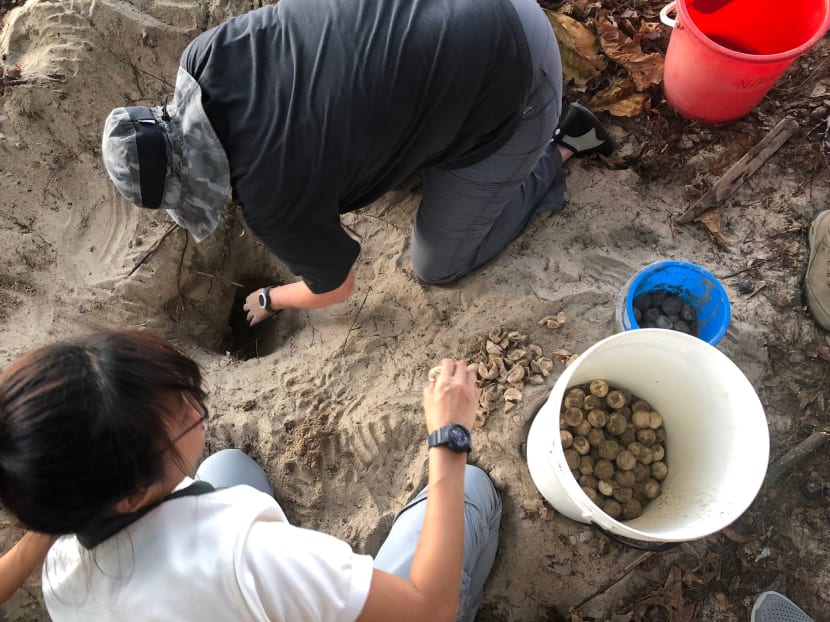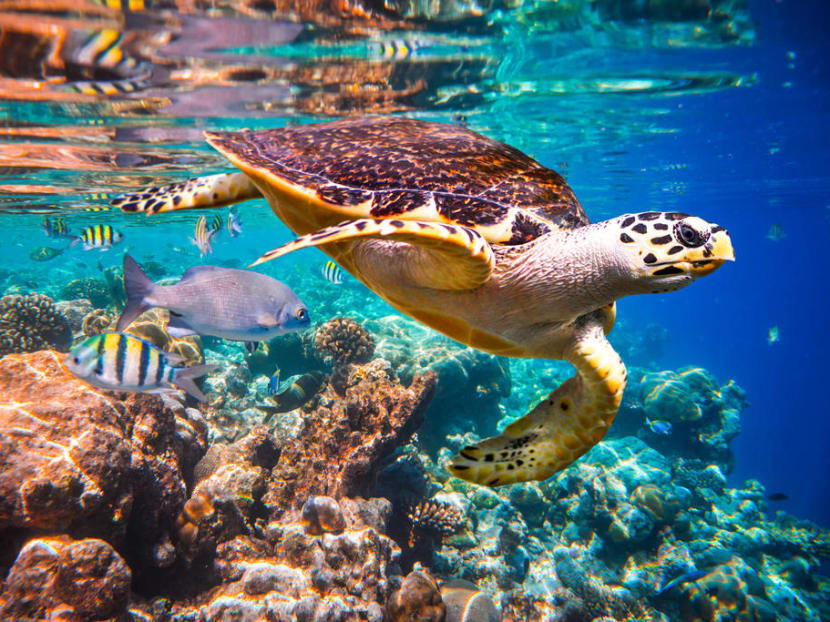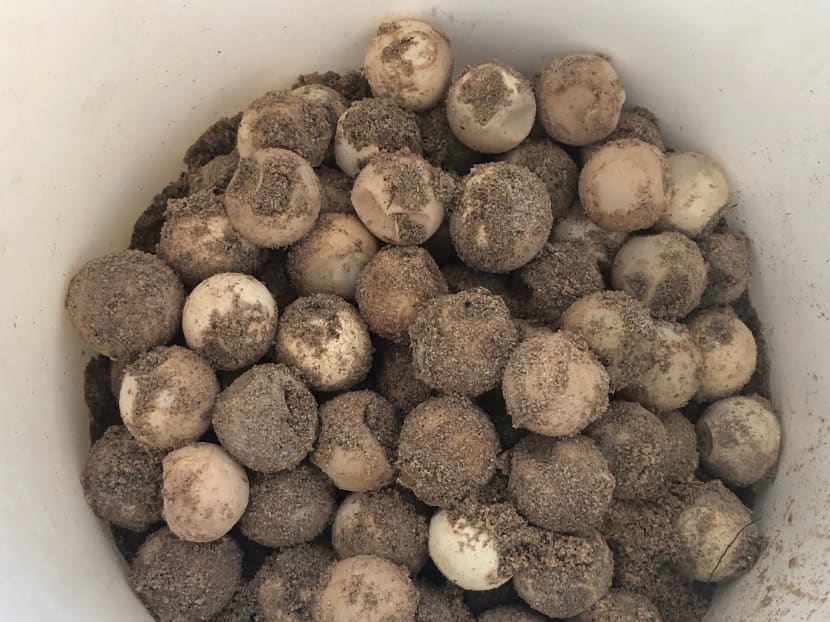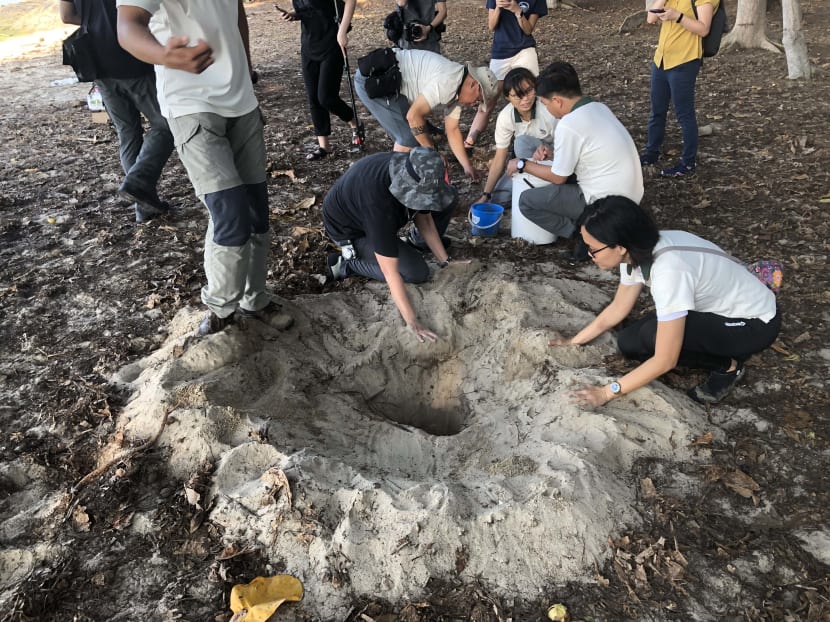Moving turtle eggs a labour of love as hundreds of volunteers help find nests in Singapore
SINGAPORE — Two trails across the sand, half-dug holes and a pile of loose sand. They may not look like much to a casual observer, but to the trained eye, they are all tell-tale signs that the critically endangered Hawksbill turtle or endangered Green sea turtle has freshly nested.

National Parks Board's staff members and volunteers taking up the delicate task of transplanting nearly 100 turtle eggs from East Coast Park to safer surroundings at the Sisters' Islands.
SINGAPORE — Two trails across the sand, half-dug holes and a pile of loose sand.
They may not look like much to a casual observer, but to the trained eye, they are all tell-tale signs that the critically endangered Hawksbill turtle or endangered Green sea turtle has freshly nested.
As many as 200 volunteers with the National Parks Board (NParks) have been busy trying to spot signs of these creatures since nesting season started in June.
And partly because so many volunteers are now patrolling Singapore’s coast into the wee hours of the night, recorded turtle activity has seen an encouraging uptick. Some of these volunteers have even been camping overnight on the Southern Islands that are accessible only by boat.
From 2005 to 2016, only 66 turtle sightings were recorded in Singapore. Although not a directly comparable figure, last year alone, there were 62 nest-related sightings.
This suggests that more turtles than previously thought — Hawksbills in greater numbers than Green sea turtles — treat Singapore’s shores as safe havens.
Historically, turtles have been slaughtered for their meat, skin and shells. More recently, the busy waters that serve as their habitat have been made perilous through large-scale fishing equipment and potentially lethal plastic waste.
Sightings of the creatures in Singapore also bring opportunities to witness baby turtles emerging from their shells during nesting season.
Last year, conservationists from NParks were able to monitor births from nine clutches of eggs — all of them turned out to be Hawksbill eggs — and to help orientate the hatchlings back into the sea.

The critically endangered Hawksbill turtle is found in tropical waters, including around Singapore. This one is in a coral reef in the Maldives. Photo: Andrey Armyagov/Shutterstock.com
As mother turtles sometimes nest on parts of Singapore’s coastline which see significant human traffic, three of these nine clutches had to be dug out of their chambers and shifted to Sisters’ Islands to increase the hatchlings’ chances of survival. Typically, each clutch has more than 100 eggs.
The smaller of the two Sisters’ Islands — out of bounds to the general public — is where Singapore’s first turtle hatchery is located. It was launched in September last year within the wider Sisters’ Islands Marine Park.
These figures were given by the authorities as TODAY tagged along on the second of this year’s relocation efforts on Wednesday (Aug 21). The event saw close to 100 eggs being dug up and transplanted from East Coast Park onto Sisters’ Islands.
Estimated to be 51 days old, the eggs are due to hatch this Sunday. Turtle eggs usually hatch on the 55th to 60th day.
This particular clutch was discovered by a student researcher from the National University of Singapore who volunteers with NParks, and the agency made the call to move it because it was located near a construction site. Over the last two months, volunteers had found hatchlings getting lost there.
Mr Collin Tong Hor Yee, senior manager of the coastal and marine branch at NParks’ National Biodiversity Centre, said that the newborn turtles could have been disoriented by the bright lights from the site’s equipment at night.
Baby turtles rely on moonlight reflected off the ocean’s surface to find their way into the sea.
HOW THE EGG SHIFTING IS DONE
Relocation is tedious, exacting work where one false move can destroy the life within an egg. Work for the crew started at 7.30am and ended after noon.
Mr Tong and his team first removed a metal netting that had been placed on top of the nest to protect the eggs from predators such as monitor lizards, ghost crabs or monkeys since the “smell of (the mother turtle’s) mucus” would be strong in the first few days.
The mesh cannot be magnetic, Mr Tong pointed out, because the turtles take cues from the earth’s magnetic field to navigate themselves as they enter the water. It is "like a compass" so that they recognise how to return to their birthplace to mate and lay their own eggs.
The Hawksbill turtle’s egg chamber that was excavated on Wednesday was 42cm deep, but Mr Tong’s team could not use tools to dig in case they accidentally hurt the eggs.
Using their bare hands, they scooped out the dry grainy sand little by little to uncover the clutch, which held 152 eggs, of which 44 appeared to have already hatched and 10 appeared deflated or under-developed.
Six eggs were suspected to be unhealthy, possibly fungal-infected, and were placed in a pail lined with damp sand. The rest of the 92 “good” eggs were put in another pail.

The eggs must be handled very carefully, because rotating them can kill the embryonic turtles. Photo: Wong Pei Ting
Mr Tong explained that when the eggs are lifted from the chamber to be placed in the pail, they cannot be rotated because that can kill the embryos, which are attached to the top of the shells. When they are moved, they must be placed on the same side as when they were found in the nest.
His team delayed the transplanting effort because the eggs are best left alone for the first three weeks after they were laid.
Over at the hatchery on Sisters’ Islands, Mr Tong’s team created a 42cm-deep hole similar to the chamber that the mother turtle had dug, and started gently placing the eggs back into the sand — again observing the same crucial rule of not rotating the eggs.
The hole was dug within one of the hatchery’s three purpose-built metal cages by the beach to protect the hatchlings and eggs from predators, such as monkeys living on the island.
A temperature logger is used to ensure the eggs are kept in a 29°C environment, which is ideal to ensure a mix of male and female hatchlings. Too cold, and all the hatchlings will turn out male. Too hot, and all of them will be female, research found.

NParks staff members and volunteers spent all morning on Wednesday (Aug 21) to carefully transplant turtle eggs. Photo: Wong Pei Ting
As the hatchery is not manned round the clock, a motion sensor is attached to the cage to detect any activity and will alert someone once hatchlings emerge, so that the turtles can be returned to the ocean.
Apart from the newly relocated batch of eggs, the remote Sisters’ Islands are home to two other clutches of identified nests which are being monitored, with the eggs left where they were laid. The eggs are due to hatch on Sept 4 and 18.
A TURTLE’S FAILED ATTEMPT
Just as the relocation work was about to be completed on Wednesday, an excited Dr Karenne Tun, NParks’ director of the coastal and marine branch, hurried over, exclaiming that fresh tracks were spotted on an adjacent beach.
It was 11am, and Dr Tun said: “The turtle just left two hours ago. The fellow spent six hours on land instead of two hours.”
She and other NParks personnel gauged the turtle's time spent onshore based on the tide and tracks that are still visible on the sand. Another indicator was that the points of entry and exit were far apart.
She held high hopes that the turtle had laid some eggs, noting that she had seen tracks like this only twice over the last three years when her department had ramped up work on turtle conservation. “She spent a long time on land, so hopefully there is a nest.”
But on closer inspection, it appeared that the turtle had walked a long way inland, dug two holes along the way and made more uncommitted attempts, before waddling back into the sea disappointed. The team could not find any deposit of eggs despite running their fingers through the loosened sand.
How do they know? It was clear that there was a “disturbance” in the area, Dr Tun remarked, tracing the turtle’s path by its tracks on the sand, and loose sand where its flippers had ruffled. The turtle possibly deemed the two holes it dug unsuitable: One had big roots which may have grown into the eggs, and it could not dig deeper with the other.
“She (the turtle) might try again tomorrow,” Dr Tun said, still hopeful. Nesting season does not end until the start of October.








